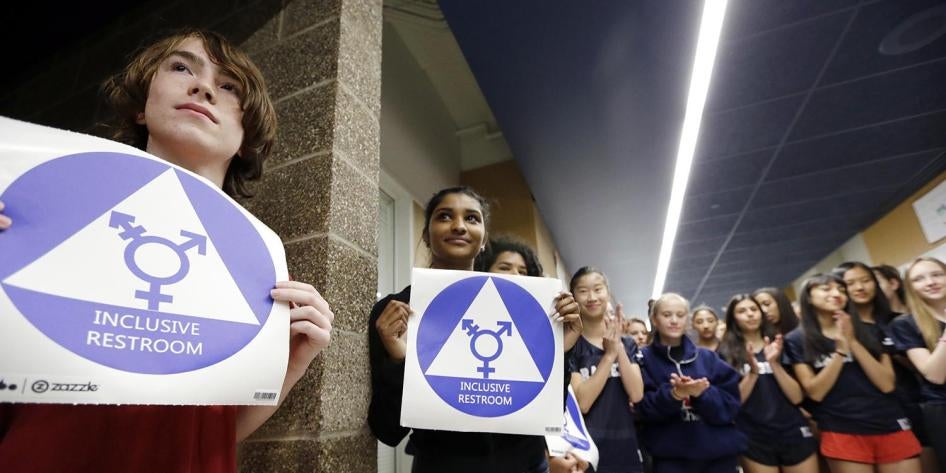(New York) – Many schools in the United States are putting the safety and health of transgender students at risk by barring them from bathrooms, locker rooms, and other facilities matching their gender identity, Human Rights Watch said in a report released today. At the end of August 2016, federal guidance instructing schools to provide that access was blocked pending the outcome of a lawsuit challenging the federal government’s action, leaving transgender students vulnerable to discriminatory policies as the school year begins.
The 23-page report, “Shut Out: Restrictions on Bathroom and Locker Room Access for Transgender Youth in US Schools,” examines how transgender youth are adversely affected by rules that bar them from using bathrooms and locker rooms matching their gender identity. Transgender students described how these rules have given rise to physical and verbal harassment, and adversely affected their physical and mental health, academic achievement, and participation in school.
“Politics aside, schools should ensure that the rights of transgender youth are respected and protected on campus,” said Ryan Thoreson, a fellow in the lesbian, gay, bisexual, and transgender (LGBT) rights program at Human Rights Watch. “Schools aren’t doing that if transgender students spend their days worrying about something as basic as finding a safe and accessible bathroom.”
Willow I. (names used are pseudonyms), a 14-year-old transgender girl in Texas, said that her school required her to use the boys’ locker room even after she had been assaulted by a group of football players there. “I had to strip down into my girly underwear in front of a bunch of guys who would call me these rude names,” Willow said.
Tanya H., the mother of a 9-year-old transgender boy, said that her son was required to use the girls’ bathroom and harassed by his peers. After he stopped going to the bathroom and mentioned suicide, she enrolled him in a new school that recognized him as a boy, with a noticeable boost in his mental well-being. “He’s so much happier,” Tanya said. “He’s making friends who know him as a boy.”
While all students should be able to access options consistent with their gender identity, some students expressed a desire to use “all-gender” options—for example, a faculty or nurse’s bathroom—because they did not identify as male or female or because they experienced harassment in gendered facilities. Where feasible, schools should offer these alternatives for those students who prefer them.
Many students who use all-gender options told Human Rights Watch they had difficulty accessing them or were interrogated by teachers who had not been trained on transgender issues. Silas G., a 15-year-old transgender boy in South Dakota, said “My teacher would grill me, ‘Why are you going to the nurse, why are you going to the nurse, why are you going to the nurse?’ And I got yelled at for using the faculty bathroom.”
Federal, state, and local officials and staff should take specific steps to ensure that transgender students are able to access facilities comfortably in their schools, Human Rights Watch said. Both federal and state governments should enact legislation prohibiting discrimination on the basis of gender identity in education and as well as in public accommodations such as retail, entertainment, and service establishments.
Locally, school administrators should issue guidelines clarifying that students should use facilities consistent with their gender identity, open all-gender options where feasible, and train teachers to be aware of the needs of transgender students.
“Transgender students are in school to learn like any other student,” Thoreson said. “The fervor over this issue shouldn’t prevent schools from doing everything they can to ensure that all students have access to facilities they can use safely, reliably, and comfortably.”











